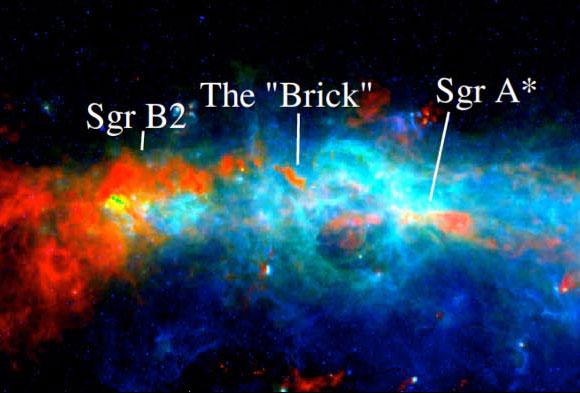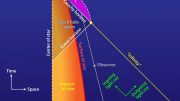
(Click for full image) An infrared and multi-wavelength image of the Central Molecular Zone in the Milky Way. Dense gas is shown in red, and warm and cold dust in green and blue respectively. Several key objects in the region are labeled, along with a set of embedded young stellar clusters seen at 24 microns. C. Battersby
New research confirms that the Milky Way’s Central Molecular Zone is not centered on the black hole, but is offset; they also confirm that the gas motions throughout are supersonic.
The center of our Milky Way galaxy lies about 27,000 light-years away in the direction of the constellation of Sagittarius. At its core is a black hole about four million solar masses in size. Around the black hole is a donut-shaped structure about eight light-years across that rings the inner volume of neutral gas and thousands of individual stars. Around that, stretching out to about 700 light-years, is a dense zone of activity called the Central Molecular Zone (CMZ). It contains almost eighty percent of all the dense gas in the galaxy – a reservoir of tens of millions of solar masses of material – and hosts giant molecular clouds and massive star-forming clusters of luminous stars, among other regions many of which are poorly understood. For example, the CMZ contains many dense molecular clouds that would normally be expected to produce new stars, but which are instead eerily desolate. It also contains gas moving at highly supersonic velocities – hundreds of kilometers per second (hundreds of thousands of miles per hour).
Where did the CMZ come from? No place else in the Milky Way is remotely like it (although there may be analogs in other galaxies). How does it retain its structure as its molecular gas moves, and how do those rapid motions determine its evolution? One difficulty facing astronomers is that there is so much obscuring dust between us and the CMZ that visible light is extinguished by factors of over a trillion. Infrared, radio, and some X-ray radiation can penetrate the veil, however, and they have allowed astronomers to develop the picture just outlined.
CfA astronomers Cara Battersby, Dan Walker, and Qizhou Zhang, with their team of colleagues, used the Australian Mopra radio telescope to study the three molecules HNCO, N2H+, and HNC in the CMZ. These particular molecules were selected because they do a good job of tracing the wide range of conditions thought to be present in the CMZ, from shocked gas to quiescent material, and also because they suffer only minimally from cluttering and extinction effects that complicate more abundant species like carbon monoxide. The scientists developed a new computer code to analyze efficiently the large amounts of data they had.
The astronomers find, consistent with previous results, that the CMZ is not centered on the black hole, but (for reasons that are not understood) is offset; they also confirm that the gas motions throughout are supersonic. They identify two large-scale flows across the region, and suggest they represent one coherent (or at most two independent) stream of material, perhaps even spiral-like arms. They also analyze the gas in several previously identified zones of the CMZ, finding that one shell-like region thought to be the result of supernova explosions may instead be several regions that are physically unrelated, and that a giant cloud thought to be independent is actually an extension of the large-scale flows. The scientists note that this work is a first step in unraveling an intrinsically complex galactic environment, and that pending research will trace the gas motions to larger distances and try to model the CMZ gas motions with computer simulations.
Reference: “Molecular gas kinematics within the central 250 pc of the Milky Way” by J. D. Henshaw, S. N. Longmore, J. M. D. Kruijssen, B. Davies, J. Bally, A. Barnes, C. Battersby, M. Burton, M. R. Cunningham, J. E. Dale, A. Ginsburg, K. Immer, P. A. Jones, S. Kendrew, E. A. C. Mills, S. Molinari, T. J. T. Moore, J. Ott, T. Pillai, J. Rathborne, P. Schilke, A. Schmiedeke, L. Testi, D. Walker, A. Walsh and Q. Zhang, 12 February 2016, MNRAS.
DOI: 10.1093/mnras/stw121
arXiv:1601.03732









CMZ the Central Molecular Zone of the constellation Sagittarius winding through the scorpion’s sting consists of 100 million Sun’s mass of stellar gases dissipating in all the directions and not centered at one particular Black Hole reminds the situation where some Dark Matter at the center dissipates the gases at fantastic speed. It happens to be a reservoir of all the galactic mass seeded to become billions of stars in the future.Thank You.